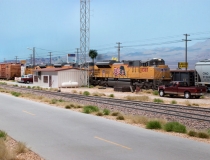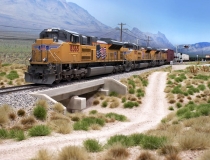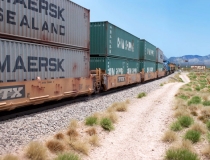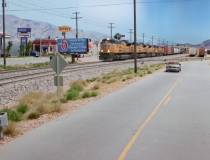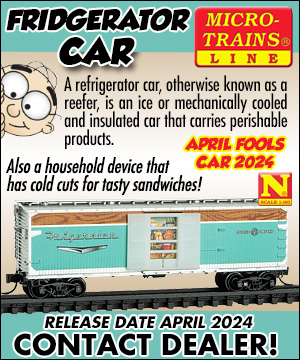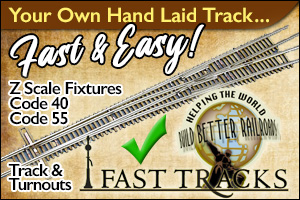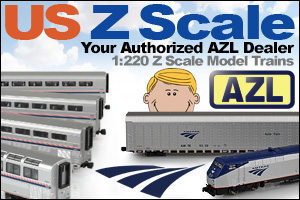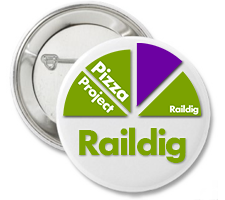Pelle K. Soeeborg
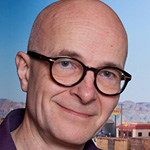 When you’re involved in model railroading for awhile there are a handful of notable names you’ll come across time and time again, people whose modeling work stands out from the rest. Pelle K. Soeeborg is definitely one of these names.
When you’re involved in model railroading for awhile there are a handful of notable names you’ll come across time and time again, people whose modeling work stands out from the rest. Pelle K. Soeeborg is definitely one of these names.
When I began looking at model railroad scenery set in the US Southwest, I’d come across Pelle’s name and photos on a regular basis for very good reasons, his work and his photography are stunning! Pelle works in HO scale but his aesthetic sense and style can be studied, and borrowed from, by all model railroaders. I contacted Pelle recently and he was gracious enough to be our Ztrains Guest. Enjoy!
Can you tell us a little bit about yourself and how you became involved in model railroading?
I have always liked trains and like most European men of my age, I had a Marklin train as a kid. When I became a teenager, I lost interest in my Marklin trains and sold them all. On a summer afternoon in the early start of the 90s I went to a specialty book store in Copenhagen – I don’t remember what I went there for but while I was waiting in line to pay for whatever I got, I spotted a basket full of old copies of Model Railroader Magazine. I picked one of them up and looked at the cover thinking: wow, is that really a model? I ended up buying them all.
The magazines inspired me to take up my childhood hobby but this time I wanted to give American trains a try. I soon realized that models of American prototypes were as good as non-existent here in Europe at the time, but I managed to get hold of something via mail order from the US. Remember this was before the internet was a common thing.
You’ve written several books for Kalmbach Publishing, including: Mountain to Desert: Building The HO Scale Daneville & Donner River. Living in Denmark, how did you become interested in US railroads and specifically, the railroads often associated with the US Southwest?
As mentioned my interest in modeling American railroads was caused by Model Railroader Magazine. My first attempt to build an American railroad scene was not successful. It didn’t look right and I couldn’t really figure out what was wrong with it. At the time, I had never been in the US and decided that I needed to go there and see how it really looked. I got in contact with a passionate train photographer from Southern California who recommended me different good railroad locations in California.
I arrived in Los Angeles in the summer of 1992 and my very first stop was in Mojave where I had breakfast at Denny’s and while I was sitting with my coffee at a window table, a beautiful lash-up of sparkling new red and silver Santa Fe Warbonnets rolled by, followed by and endless string of flat cars with trailers. That was my first impression of American railroading. I spent several days exploring the Tehachapi, which also became the prototype for my first layout. As you can see, Mojave never left me. To me it represented the perfect western railroad town and the town “Daneville” on both my previous and my present layout is based on Mojave. Over the years I have traveled a good part of the US but my heart belongs to the vast spaces of the Southwest.
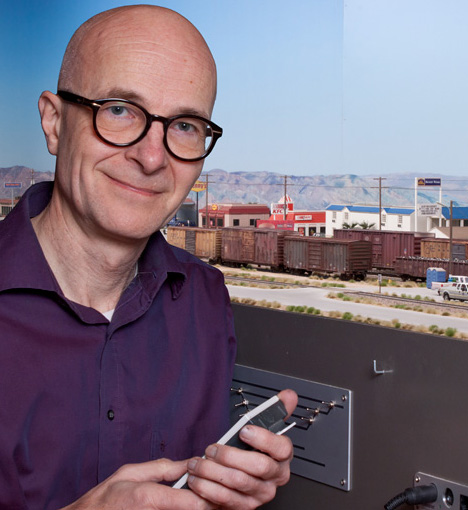
Your scenery work is amazingly realistic; did you have any model railroading influences when you began your work?
I remember a couple of fantastic layouts from my first copies of Model Railroader Magazine. One of them was called “the Berkshire Lines” or something like that. It was a club layout featuring New England railroads. Another was David Barrow’s “Cat Mountain & Santa Fe” and Chuck Hitchcock’s “Santa Fe Argentine Division”. Even though I would never have the space for a model railroad of this magnitude, I was captured by the balance between the scenery and the track. The realism of these model railroads was stunning, nothing like the spaghetti bowl of track I remembered from the layouts featured in my childhoods Marklin catalogs.
Two areas that stand in your photos are your soil and your pavement work. Do you have any tips that you could share with our readers?
The key to realistic looking soil and pavement is using light colors. When I tried to use real Mojave dirt on my layout, it looked too dark so I “diluted” it with lighter dirt to make it look right. To make the roads look realistic I paint them in a color that matches the surrounding scenery. If the road runs through a desert, I mix the gray asphalt color with a beige color. A desert road is covered with dust and the pavement will therefore take a lighter and warmer shade of gray than a road in more lush green or urban areas.
What sort of advantages or disadvantages do you think Z scale, or even N scale, modelers face when trying to create high quality scenery?
I have always modeled in HO scale and have never tried to model in N and Z scale but I would assume you can make just as convincing scenery in these scales as in HO. Nowadays you can get so many great looking scenery materials.
Another book you’ve written for Kalmbach is titled: Essential Model Railroad Scenery Techniques. Now I don’t want to give away too much here, but are there one or two top techniques or ideas that you think are especially important for good scenery?
One thing could be that applying all ground cover including the ballast to a scene before wetting and gluing it. Not only makes this scenery building quicker but the scenery materials also blends together in a more natural way.
You’ve obviously seen lots of other train layouts. This question is very subjective of course, but in your view what elements do you think separates very good layouts from average layouts?
I haven’t seen that many actually. What separates the good ones, in my opinion, is when the scenery dominates the track. I like when you get the impression of a landscape with a track in it and not a track with some landscape around it. Modeling in smaller scales like N and Z will definitely be an advantage regarding this issue. I know most of us who are modeling in HO scale don’t have the space for building a model railroad that way, myself included, but I have tried to keep the amount of track on my layouts to a minimum to obtain the most space for scenery.
When a new modeler sees scenery like yours it’s possible that they could become discouraged, thinking they could never achieve these results. What advice would you give to a new and enthusiastic scenery builder?
The techniques I use are not complicated at all so I will say that with a little practice anybody can achieve a good result. My best advice is to use your eyes. If a scene doesn’t look right to you it will probably not look right to others too. We all make mistakes but as long as we learn from them, it is not a problem. My second layout was better than my first, my present layout is better than the one before, and my next will probably be better than my present.
Another element to your work that stands out is your locomotive and rolling stock weathering. You’ve spoken about airbrush use previously but we still see many model railroaders hesitant to use an airbrush. What are your thoughts on single vs. double action airbrushes, and what would you suggest for a beginner?
I will definitely recommend a double action airbrush. Especially when you weather models, it is essential that you can control the air and paint flow individually. I know that many modelers have a fear of using an airbrush and it could be because their only experience in airbrushing has been with a cheap single action airbrush. It is difficult to control the amount of paint you apply to your model, especially on a limited area, with a single action airbrush.
Invest in a high-end double action airbrush and a good compressor with an air tank then you will discover that it might not be as difficult as you think.
Much of the realism from your weathering comes from its subtle application… not every car is ancient or rusted through. Do you have an overall philosophy when weathering locos and rolling stock?
Not really, except that I try to reflect what I see when I go rail fanning.
Thanks very much for taking time for our readers, but before I let you go just one more question. I see you have a new book coming out: Rebuilding a Layout from A-Z. Given how beautiful the Daneville & Donner River layout was, why did you decide to rebuild?
A lot of reasons. The most important is probably noise reduction. On my old layout, there was a high level of track noise and I didn’t pay much attention to it until I started running sound equipped locomotives. The wheel noise from the freight cars almost overpowered the sound in the locomotive.
Another reason for rebuilding the layout was that I over the time had spotted so many things I wished I had done differently so I simply felt that the time was right for doing a re-build. I also tend to lose interest in my layouts when they are finished. I am a builder more than an operator.
Pelle K. Soeeborg books at Amazon.com | Pelle K Soeeborg Website
Category: Raildig Guest




